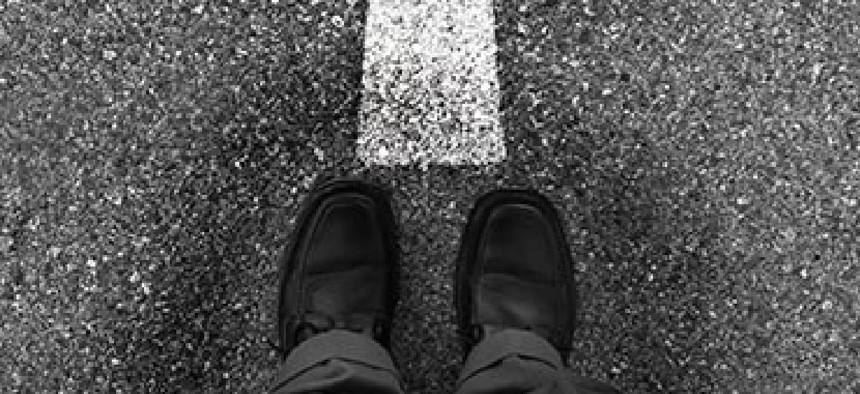Walking toward change

A father-daughter story about cancer recovery and organizational improvement.
A father-daughter story about cancer recovery and organizational improvement

Jody Kelman leads self-driving vehicle rollout on the product team at Lyft, the ridesharing company. Her dad is Steve Kelman, author of The Lectern blog. The idea for this blog came from Jody, and she and her dad wrote it together.
Jody: My dad and I have been remarkably close since I was born. We share a sense of humor, an insistent curiosity, and a firm commitment to making the world a better place.
Steve: So when I was diagnosed with cancer, it hit Jody hard. And since my treatment, which seems to have knocked out the cancer, she has been trying to help me deal with some of the follow-on effects of the cancer and the treatments, including my difficulty walking due to weakness in my left foot, which has proved very frustrating on a daily basis.
Jody: My dad has always been the most positive, can-do person I know. The part of his illness that no one prepared us for was recovery: How difficult it is to build back up to your pre-cancer quality of life after aggressive chemotherapy and a stem-cell transplant. Doctors had prepared us for the treatment, but not for the hard work and cooperation that it was going to take to get my dad back on his feet, literally. That has proven much harder than any of us, including him, expected. A man who used to walk Boston’s Walk for Hunger annually, and who could easily log a dozen miles in a day on foot on his trips to Paris, Stockholm, or Beijing was now shuffling and dragging his left foot when he walked. His daily three-quarters of a mile walk to catch the train to work had become a major challenge.
Steve: So when I called Jody to let her know that I had experienced a step-change improvement in my walking, she was thrilled. She was also curious. What, she wondered, had changed?
Jody: My dad told me that the breakthrough moment had come in at a physical therapy session . He had spent months complaining to us about his frustration with his walking on his left side, and had consulted a few doctors and physical therapists about the problem. They had prescribed some exercises, primarily to strengthen his left ankle so he could better lift his left toe off the ground. This was working a bit, but not well enough. Then a new physical therapist, Josh, presented him with a new idea.
Steve: Josh made a simple request: Walk for me. While I walked -- back, forth, and back again -- he and my wife watched. They observed that the action I took with my bad left foot didn’t match the action I took, without even thinking about it, with my normal right foot. On the right side, I walked toe up with heel down, toe down, push off toe and bring heel up,. But on the left, I had been told in prior therapy sessions (or at least that is what I thought I had been told) that my problem was that my left foot was too weak to raise my toe, so I needed to concentrate on that. I did that but after I raised the toe, I did not pay attention to how I put my foot back down on the ground. Josh noticed that after raising my toe I put my entire foot back down on the ground, and it dragged when I tried to move it forward from that position. Based on his observation, Josh offered me an insight: What if I attempted to mimic the actions of my good foot, adopting this same follow-through on my left side? When I made this slight change, my walk suddenly felt much more natural, more like it had before my illness. Over the coming weeks, with my wife pairing with me as coach, I began to practice this toe-up, toe-down, push-off follow-through movement when I walked. The result has been impressive: I have experienced a marked improvement in my gait.
Jody: As long-time students of management, my dad and I both realized that this story contains a powerful analogy for organizations. In organizations, individuals often complain about a problem, but months - or even years - go by without the organization solving it. The reason is that organizations too often get stuck in a simplistic problem-solution pattern: The moment someone identifies a problem, someone else jumps in with a solution. But too often that solution is tailored to the wrong problem, or only to a part of the problem. In my dad’s case, he was prescribed a solution that made his ankles stronger, but missed a key element of his walking difficulties that came not from ankle weakness but from the pattern of his motion.
Steve and Jody: As we started to discuss it, we realized that the three-part method that has been so successful with my walking could be highly applicable to making positive change in any organization. First, when a problem is identified, don’t jump directly into solutions. Instead, shift into observation mode to understand more specifically where the process or the organization is breaking down. Don’t assume you know what is wrong from past practice or pattern recognition -- observe each step analytically to understand where the problem occurs. Second, translate your observations into insight. There is an a-ha moment where your observations gel into a specific new action or actions that needs to be undertaken. Finally, once you have gotten to an answer, it is crucial to enshrine that insight with regular practice, just as athletes do in learning a new routine. Many organizations fail to become self-conscious about the need to practice the new behaviors so people learn them and gradually assimilate them into how they automatically do their jobs. Finally, don’t let people do it alone: Teams are invariably stronger when practice comes with constructive feedback that reinforces each other’s successful new practices, just as my wife was kind enough to do with me. This three-part method has proven powerful in improving my walking -- and I think may be a powerful lesson for managers in many organizations.
Jody: I’m lucky to have one of the greatest dads in the world -- and one of the few who would want to use his own recovery journey as a great excuse to co-author a management blog with his daughter. But mostly, I’m thrilled that you are on a road back to those long, pleasant walks -- and I’m looking forward to walking by your side.
NEXT STORY: USDA moves CIO to new post


